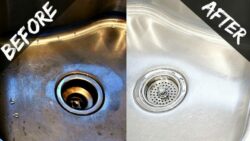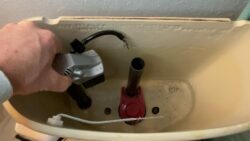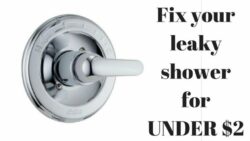In this informative article, you will be provided with 12 practical and straightforward methods to effectively and efficiently unclog a sink. Whether you’re dealing with a minor drain issue or a persistently clogged sink, the techniques outlined in this guide will equip you with the necessary knowledge to restore proper drainage. From utilizing natural ingredients found in your kitchen to employing household tools, these easy-to-follow solutions will allow you to tackle this common household problem with ease and professionalism.
Use a plunger
A plunger is a handy tool that can effectively remove clogs in sinks. To start, choose a plunger specially designed for sinks. The cup of the plunger should fit snugly over the drain opening. Before using the plunger, apply a thin layer of petroleum jelly to the rim of the cup. This will create a tighter seal and improve suction. Next, cover any overflow holes near the sink using duct tape or a wet cloth. This will prevent air from escaping through the overflow holes, allowing the plunger to create more pressure.
To create a seal, position the plunger cup over the drain opening, ensuring that it is centered. Press down firmly so that the cup forms a tight seal against the surface. This seal is crucial for effective plunging. To plunge the drain, push and pull the plunger up and down with force. This action creates suction, which helps dislodge the clog. Continue plunging for a few minutes, maintaining a strong seal throughout the process.
After plunging, remove the plunger and test the water flow to see if the clog has been cleared. Run water down the drain and observe if it flows smoothly. If the water still drains slowly or is completely blocked, you may need to try another method.
Boiling water
Boiling water is a simple yet effective method to unclog a sink. Start by boiling a pot of water. Once the water has reached a rolling boil, carefully pour it down the clogged drain in a slow and controlled manner. The hot water helps to melt and break down the clog, allowing it to be flushed away. It is important to pour the water slowly to avoid splashing or causing damage.
After pouring the boiling water, let it sit for a few minutes. Then, test the water flow by running the tap. If the clog persists, repeat the process as necessary. Be cautious not to use boiling water on porcelain sinks, as sudden temperature changes could cause them to crack.
Baking soda and vinegar
Baking soda and vinegar are natural and non-toxic ingredients that can work together to unclog a sink. Start by pouring half a cup of baking soda down the drain. Follow this by pouring an equal amount of vinegar.
The mixture of baking soda and vinegar creates a chemical reaction that generates foam and bubbles. This foaming action helps break down the clog. Allow the mixture to sit for about 15 minutes, allowing it to work its way through the drain. After the waiting period, flush the drain with boiling water. The hot water helps rinse away the dissolved clog and clears the drain. Repeat this process if needed, until the water flows freely.
Hot water and salt
Another effective household remedy to unclog a sink is by using hot water and salt. Begin by dissolving half a cup of salt in a pot of hot water. Stir well until the salt is fully dissolved. Once the salt is dissolved, carefully pour the solution down the drain. The hot water helps to break down the clog while the salt adds abrasiveness, aiding in dislodging the debris. Allow the solution to sit in the drain for about 15 minutes. Then, flush the drain with hot water to wash away the dissolved clog. Repeat the process if necessary, until the water flows smoothly.
Wire hanger
For stubborn clogs that cannot be easily removed with plunging or liquid solutions, a wire hanger can be a useful tool. Start by straightening out a wire hanger and creating a small hook at one end. Insert the hooked end into the drain and carefully maneuver it, trying to catch and pull out the clog. It may take some patience and effort to dislodge the debris. Once the clog has been removed, flush the drain with hot water to ensure it is completely clear. This method is particularly useful for removing hair clogs or other solid obstructions.
Baking soda and salt
Mixing baking soda and salt can be an effective DIY solution to unclog a sink. Begin by combining equal parts of baking soda and salt. Half a cup of each should be sufficient for most clogs. Pour the mixture down the drain and allow it to sit for a few hours, preferably overnight. During this time, the baking soda and salt will work to break down the clog. After the waiting period, flush the drain with boiling water to clear away the dissolved debris. Repeat the process if needed until the water flows freely.
Wet and dry vacuum
If you have access to a wet and dry vacuum, it can be a powerful tool to unclog a sink. Set the vacuum to wet mode and make sure it is positioned near the sink. Cover the vent with a cloth or towel and ensure it is tightly sealed. This prevents any air from escaping, allowing maximum suction power. Next, create a tight seal around the drain by placing the vacuum nozzle directly over it. Press down firmly to establish a strong connection.
Turn on the vacuum and let it run for a few minutes. The suction created by the vacuum should help dislodge the clog. Once the vacuuming process is complete, remove the vacuum and flush the drain with water to ensure the clog has been fully cleared.
Use a plumber’s snake
A plumber’s snake, also known as a drain snake or auger, is a specialized tool designed to remove clogs that are deep in the pipes. When using a plumber’s snake, it is essential to choose the appropriate one for your sink. Insert the snake into the drain, turning and pushing it carefully to navigate through the pipes. The snake’s flexible rod should help break up and remove the clog.
Continue rotating and pushing the snake until you feel it encounter resistance. This resistance indicates that the snake has reached the clog. Use additional force if necessary to break up the obstruction. Once the clog has been broken up, remove the snake from the drain. It is important to flush the drain with water to ensure the debris is fully cleared.
Dish soap and hot water
Dish soap and hot water can be a simple and effective combination to unclog a sink. Begin by squirting a generous amount of dish soap into the drain. Follow this by pouring hot water down the drain. The dish soap helps to lubricate the pipes, while the hot water aids in breaking down the clog.
Let the mixture sit in the drain for a few minutes. This allows the dish soap and hot water to penetrate the clog and loosen it. After the waiting period, flush the drain with hot water to rinse away the dissolved debris. Repeat the process if necessary, until the water flows smoothly.
Call a professional plumber
If all else fails and the clog remains stubborn, it may be time to call a professional plumber. Assess the severity of the clog and determine if it requires expert intervention. Research and hire a reputable plumber who specializes in sink clogs. Ensure they have the necessary qualifications and experience to handle the issue effectively and efficiently. By calling a professional, you can have peace of mind knowing that the clog will be addressed properly, minimizing the risk of further damage to the sink or plumbing system.
In conclusion, there are several methods you can use to unclog a sink, ranging from simple DIY solutions to seeking professional help. By following these steps outlined above, you can effectively tackle most sink clogs and restore proper drainage in your kitchen or bathroom. Remember to exercise caution and always prioritize safety when attempting to clear a clog.





